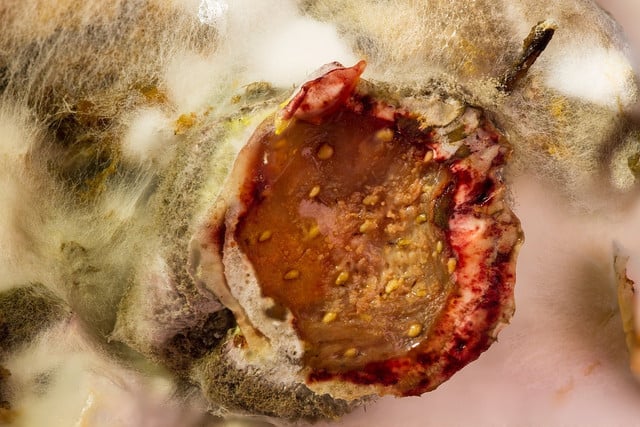Mold on strawberries is a common occurrence. Read on to learn whether you can still eat a moldy strawberry, and how to avoid mold in the future so that you can enjoy fresh strawberries for longer.
Why Do Strawberries Go Moldy?
Fresh strawberries can go moldy very fast because they are very porous fruits and are able to soak up moisture from the air easily. Mold spores can quickly develop on their surface and eventually seep into the flesh of the fruit.
Are There Different Types of Mold?



(Foto: CC0 / Pixabay / adege)
The most common type of mold found on strawberries is caused by the fungus Botrytis cinerea. This fungus infects the strawberry, causing it to develop grey and fluffy mold on the surface.
Other, less common types of mold, include Cladosporium (also often found on carpets and walls) and Alternaria alternata (often found on textiles or on other foods like potatoes).
How Fast Do Strawberries Get Moldy?
Fresh strawberries can go moldy very fast.
- If strawberries are not refrigerated, they can last one to two days before growing mold.
- If stored in the refrigerator, they can last between five to seven days before going bad.
Strawberries can also be frozen for long-term storage. They will, however, lose their consistency – but you can still use them as puree.
How Can Mold be Avoided?



(Foto: CC0 / Pixabay / elizadean)
There are a number of ways you can avoid your fresh strawberries going moldy. Follow these quick steps you can take to help keep the delicious fruit fresh for longer:
- Do not wash your strawberries before storage. Keep the moisture down to reduce the risk of mold growth.
- If you do want to clean them in advance, you can use a vinegar bath. Vinegar kills bacteria and mold spores. In a bowl, combine four-parts cold water with one-part vinegar and let your strawberries soak in the liquid for two minutes. Gently swish the strawberries around to remove any spores or bacteria before draining them and rinsing them well in cold water.
- Sort through the strawberries before storing them away. Throw away moldy ones and snack bruised ones. Strawberries that have been in direct contact with the mold should also be removed.
- Place your strawberries in an airtight container. Place a paper towel at the bottom of a clean tupperware and place your strawberries on top, ideally in a single layer. The paper towel will catch any excess moisture and keep your strawberries fresher for longer.
- Store your strawberries in the fridge. This will slow down the process of molding.
Can Moldy Strawberries Still be Eaten?
Moldy strawberries should not be eaten. If you eat one accidentally, it will probably not cause serious illness. But some molds can cause allergic reactions or respiratory problems like sneezing or a runny nose. The USDA highly recommends avoiding eating any foods with mold on them, especially softer fruits like strawberries. Moldy strawberries should be thrown out in their entirety.
If there is just one strawberry within the box that is moldy, this strawberry should be thrown out immediately. Any other strawberries that were in direct contact with the berry should also be thrown out, to be safe. If the other berries show no signs of mold or contamination, they are safe to eat. Just be sure to wash your strawberries thoroughly right before eating them.
What to Do When You Eat a Moldy Strawberry
If you eat a moldy strawberry, the likelihood is that nothing serious will occur. Allergic reactions can be delayed, so keep an eye out for any symptoms such as shortness of breath, nausea, diarrhea or fever in the days that follow. If any of these symptoms occur, contact a doctor.
Read more:
- Storing Food Correctly: 7 Tricks for Vegetables, Fruits and Leftovers
- Nice Cream Recipes: Vegan Banana Ice Cream in Five Minutes
- How to Remove Mold from Wood With Natural Remedies
Do you like this post?








